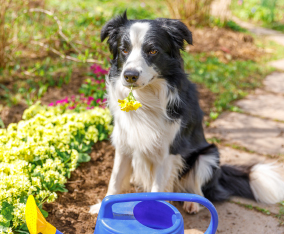SPRING PET CARE
Tips & Tricks for a Happy, Healthy Season
As the chill of winter gives way to blooming flowers and longer days, pet parents everywhere are excited to spend more time outdoors with their furrever ones. But just like humans, pets face seasonal changes that can affect their health and comfort. Spring brings new opportunities for fun, but also new risks and responsibilities.

To help you and your pet enjoy the season safely and happily, here are top tips and tricks for springtime pet care.
TACKLE SHEDDING WITH A SOLID GROOMING ROUTINE
Spring is shedding season for many pets, especially dogs and cats with thick or double coats. As they lose their winter fur, it’s crucial to brush them regularly to prevent mats, reduce hair around your home, and keep their skin healthy.
Tips:
Try using a de-shedding brush or grooming glove designed for your pet’s coat type. Brush outside when possible, to keep the loose fur out of your home. And remember to bathe your pet occasionally with a mild pet shampoo to loosen excess fur and reduce dander.
GET AHEAD OF FLEAS, TICKS, AND MOSQUITOES
Warmer weather means the return of pests. Fleas, ticks, and mosquitoes aren’t just irritating—they carry serious diseases like Lyme disease, ehrlichiosis, and heartworm.
Tips:
Start or continue flea, tick, and heartworm prevention as early in the season as possible. You have to check your pet daily, especially after walks in wooded or grassy areas. And remember to keep your yard trimmed and remove debris where ticks and fleas thrive. You should ask your vet about the best preventative treatment for your pet’s size, age, and breed.

WATCH FOR SEASONAL ALLERGIES
Springtime pollen doesn’t just affect people—many pets develop seasonal allergies too. My parents’ pugs suffer from allergies, as does our very own Spokesdog, Brioreo. Common symptoms include itchy skin, red or watery eyes, sneezing, and excessive paw licking or chewing.
Springtime pollen doesn’t just affect people—many pets develop seasonal allergies too. My parents’ pugs suffer from allergies, as does our very own Spokesdog, Brioreo. Common symptoms include itchy skin, red or watery eyes, sneezing, and excessive paw licking or chewing.
PET-SAFE SPRING CLEANING
Spring cleaning is great for refreshing your space, but it can be dangerous if you’re not careful. Many household cleaners contain chemicals that are harmful to pets if inhaled or ingested.
Tips:
It’s always best to use pet-safe or natural cleaning products whenever possible. You need to make sure you are keeping pets out of rooms where strong chemicals are being used until they’re fully dry and ventilated and store all cleaning supplies out of your pet’s reach, even if they’re labeled “green” or “natural.

GARDEN AND YARD SAFETY
Spring gardening is therapeutic for humans but can pose hidden dangers to pets. Fertilizers, pesticides, mulch, and even common plants can be toxic if ingested.
Tips:
Plant pet-safe flowers and plants such as marigolds, snapdragons, and zinnias. Avoid cocoa mulch, which is toxic to dogs. Keep pets away from areas treated with chemicals until they’re dry and safe. Fence off areas with known toxic plants like tulips, lilies, daffodils, and azaleas.
STAY HYDRATED DURING OUTDOOR PLAY
As the weather warms up, your pet may become more active, but the risk of dehydration also rises. Even mild spring temperatures can cause overheating, especially in thick-coated or short-nosed breeds like bulldogs or pugs.
Tips:
Bring fresh water and a collapsible bowl on walks, hikes, or trips to the park. Take frequent breaks in shaded areas and avoid outdoor activities during the hottest part of the day (typically noon to 4 p.m.).
PROTECT AGAINST SUN EXPOSURE
Just like people, pets can get sunburned—especially those with light-colored fur, thin coats, or exposed skin on the nose and ears.
Tips:
Apply pet-safe sunscreen to vulnerable areas if your pet is outdoors for extended periods. You need to always provide access to shade when outdoors. And, if you have long-haired dogs, avoid shaving them completely, as their coat helps regulate temperature and protects from UV rays.
UPDATE ID TAGS AND MICROCHIPS
With open windows, backyard play, and more walks, the chance of pets slipping out or getting lost increases in spring.
Tips:
Make sure your pet’s ID tag is legible and securely attached to their collar. Also, check that your contact information on their microchip registration is up to date. You could also consider a GPS tracking collar for adventurous pets.
GET MOVING THE HEALTHY WAY
Spring is the perfect time to get your pet back into an active routine after a sedentary winter. However, just like people, pets need to ease back into exercise.
Tips:
Start with short walks and gradually increase duration. Watch out for signs of fatigue or overheating. You can also use toys, agility training, or interactive games to keep your pet physically and mentally stimulated.

SCHEDULE A SPRING VET CHECK-UP
Spring is a natural checkpoint for your pet’s health. Use the new season as a reminder to schedule a wellness exam.
Tips:
Ask your vet about any necessary vaccinations, especially if you’ll be visiting dog parks, boarding facilities, or going on trips. Remember to get your pet’s dental health checked and cleaned if needed. And discuss any behavior or dietary changes you’ve noticed over the winter months with your vet.
Spring is a time of renewal and joy for both pets and their parents. With a few thoughtful precautions and consistent care, you can make sure your pet enjoys everything this season has to offer—from fresh air and outdoor play to long naps in the sunshine.
Whether it’s brushing away winter fur, guarding against bugs, or planning safe adventures together, these spring pet care tips ensure your four-legged companion thrives.
So, get outside, soak up the sunshine, and spring into action—your pet will thank you with wagging tails, happy purrs, and lots of love.








